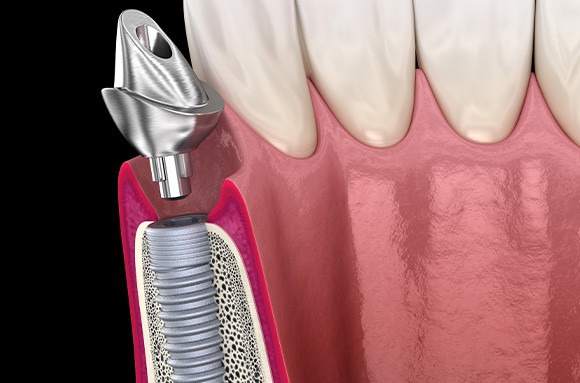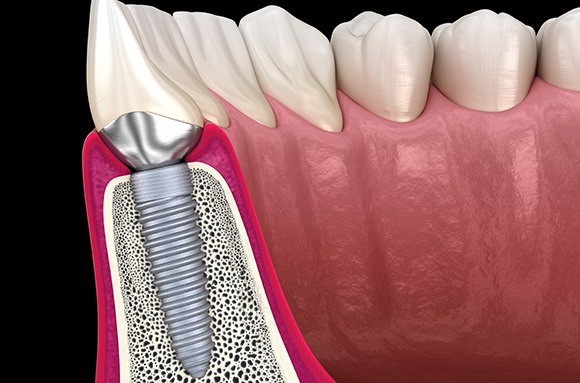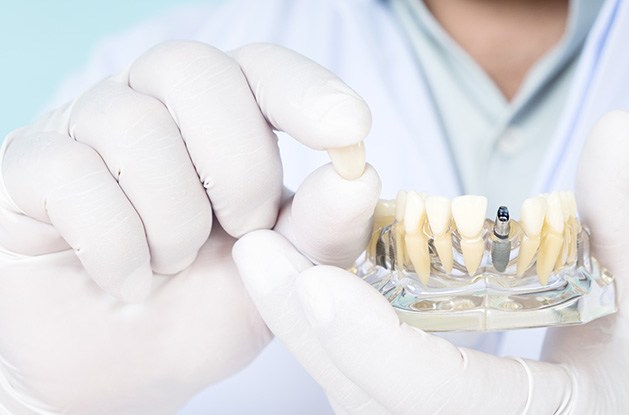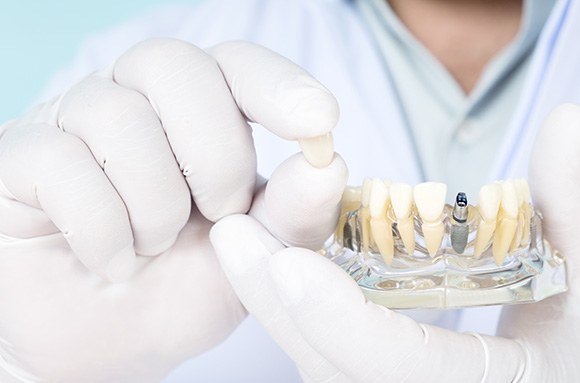Dental Implants – Westfield, MA
A Lasting Solution for Tooth Loss
For children, losing a tooth is often exciting. But for adults, it’s always a devastating event. Permanent teeth are intended to last your entire life; if they’re lost, they don’t grow back. Even if only one tooth is missing, it can still have a major impact on your oral health and your quality of life. While you can fill in the space with dentures and dental bridges, both of these restorations will likely need to be replaced every few years. Dental implants, on the other hand, offer a more permanent solution to tooth loss and are often seen as the next best thing to getting your natural teeth back. Reach out to EMA Dental of Westfield today to schedule your initial tooth replacement consultation and find out if dental implants in Westfield are the right option for you.
Why Choose EMA Dental of Westfield for Dental Implants?
- Prosthodontic Specialist and Experienced Team
- Dental Implant Placement Performed In-House
- Variety of Dental Insurance Plans Accepted
What Are Dental Implants?

A dental implant doesn’t look like a tooth on its own; instead, it’s a small post that resembles a screw. Most dental implants are made out of titanium, which is a very biocompatible material. When dental implant posts are placed in your jaw, they can form a strong bond with the surrounding bone tissue, allowing them to provide your replacement teeth with unmatched strength and stability. Also, the stimulation from the implants will help prevent bone loss in the jaw.
A small connector piece called an abutment is used to secure a customized restoration to the implant post. The number of posts required and the type of restoration used depends on how many teeth are missing. For example, a single tooth can be replaced by one implant and a crown; multiple missing teeth may call for a full denture and a minimum of four strategically placed implant posts.
The 4-Step Dental Implant Process

Compared to dentures or dental bridges, dental implants have a longer treatment process that can take months. Even so, you needn’t worry – their benefits make them worth the time and energy! Our practice places dental implants in-house to ensure you get the best results possible. Since we supervise everything, our dentists’ skills and expertise will benefit your procedure. The overall process will involve an initial consultation, surgery, osseointegration, and delivery of the final restoration.
Initial Dental Implant Consultation

To start things off, you’ll first visit our office for a consultation. This appointment lets us learn about your treatment goals, oral health, and other key factors. Once we’ve assessed these details, we can confirm whether dental implants suit your smile.
If we decide you don’t qualify for dental implants, please don’t panic. You can become a good candidate later through “extra” dental work – tooth extractions, periodontal therapy, etc. These add-on services would make your mouth healthy and strong enough to handle implant posts.
Dental Implant Surgery

Since we perform dental implant surgery in-house, our dentists oversee the placement work. That means you can expect stellar results from your treatment!
From beginning to end, the dental implant surgery will include four crucial steps:
- Numbing – To ensure you don’t feel pain during placement, we’ll numb the treatment site with a local anesthetic. The most you’ll sense from our dental work is a slight pressure.
- Incision Work – With your mouth numb, we’ll make an incision in your gums to create space for the dental implant.
- Placement – We’ll place your dental implant once the incision is made, making sure to suture your gums shut afterward.
- Capping – We’ll conclude your surgery by putting a protective cap over your dental implant.
Dental Implant Osseointegration & Abutment

Your dental implant will start fusing with your jaw after your surgery. In general, this process – known as osseointegration – takes 4-6 months to finish. Once it’s concluded, it’ll ensure your implant post is a secure and permanent part of your months.
After the implant fusion process ends, you’ll attend a follow-up surgery at our office. This procedure will place your implant’s abutment – a metal connector that secures the final restoration. As for said restoration, a dental lab will craft it while you heal from the abutment work.
Delivery of Dental Implant Restoration(s)

To conclude the treatment process, our team will deliver your dental implant’s final restoration. This device could be a simple dental crown, a dental bridge, or even an implant denture. Its type and nature will depend on how many teeth you’re replacing.
It shouldn’t take us long to fit your final restoration in place. After all, we’ll only need to apply some dental cement and make a few last-minute changes. Once we’ve confirmed you have good results, we’ll send you to enjoy your restored smile and its many perks!
Benefits of Dental Implants

Did you know that an estimated 3 million Americans received dental implants in the year 2024? These restorations continue to gain popularity because of the many unique advantages they provide over alternative options like dentures or dental bridges. They’re the only option that’s inserted directly into your jawbone for improved strength and stability.
Continue reading to learn more about some of the advantages of getting these replacement teeth at EMA Dental of Westfield, and feel free to contact us for additional information.
Day-to-Day Benefits

Tooth loss can detract from your daily quality of life because once-simple tasks, like eating, speaking, and smiling authentically, suddenly become much more challenging. Thankfully, our team can rebuild your grin with dental implants so that you can enjoy:
- Restored chewing power. Unlike dentures, which only return about 20% to 50% of your original bite force, these prosthetics replenish about 80% to 100%.
- Clearer enunciation. Patients missing teeth often develop a lisp or other changes to their speech patterns, which can be overcome with these replacement teeth.
- Easy maintenance. Keeping your prosthetic clean is as simple as brushing and flossing twice daily and visiting our team for a routine checkup every six months.
- Boosted confidence. They’re capped with a lifelike dental crown (or other appropriate restoration) customized to match your natural grin, so you can look and feel like your best self.
Health Benefits

There are additional advantages to getting dental implants that may be less immediately obvious but are just as (if not more) significant. Choosing this treatment can support your oral and general well-being because they also:
- Preserve your jawbone. Your roots stimulate new bone growth that keeps your jaw active and healthy, meaning it starts to lose mass when teeth go missing. The titanium rod of your restoration fulfills this function to maintain your bone density.
- Support your facial structure. A thinning jawbone can cause sunken cheeks and additional fine lines, which can be avoided by placing dental implants.
- Prevent dental issues. They’re easy to brush and floss so plaque and bacteria don’t accumulate, decreasing your vulnerability to tooth decay, gum disease, and other issues.
- Don’t cause sores. Dentures and dental bridges rely on your gums or healthy teeth in your mouth to remain put, which can rub sore spots into your gums or cause sensitivity. Meanwhile, implants function as sturdy stand-alone structures.
Long-Term Benefits

Many patients choose to restore their smiles with dental implants because they are known for their resilience and reliability. This treatment provides several long-term advantages, including:
- High success rate. These replacement teeth have a high success rate of 95% or more, even up to 10 years after their initial placement.
- Once your jawbone fuses with the metal rod, your implant becomes a permanent part of your smile and can last 25+ years with the proper care.
- Because it’s so stable, it’s not likely to become damaged or dislodged like dentures or dental bridges.
- Save on expenses. There’s no need to invest in adhesives, and you’re less likely to require repairs or a replacement, which saves you money over time.
Who Dental Implants Can Help

Regardless of how many teeth are missing, dental implants can be a viable choice for completing your grin and restoring your ability to eat, speak, and smile without issue. To determine whether you’re a good candidate for dental implants, we’ll need to evaluate the current state of your oral health. Sometimes preparations need to be made to ensure a successful dental implant process. If dental implants are right for you, the treatment will be customized depending on how many teeth have been lost.
Missing One Tooth

A dental implant can be placed in the gap where the missing tooth used to be. Once your mouth is finished healing, we can start the process of designing a custom crown. For the most lifelike results, our crowns are made out of materials that closely resemble natural enamel, including the way they reflect the light. The crown will feel very comfortable alongside your natural teeth, and it can completely fill in the space in your mouth to prevent dental drift.
Missing Multiple Teeth

We can use a bridge supported by two dental implants to replace multiple consecutive missing teeth. Implant bridges are very lifelike and allow you to fill in larger gaps with a single treatment. One of the most important advantages of implant bridges is that they don’t require any changes to your natural teeth. Instead of being placed on abutment teeth (which would require us to remove some enamel), the bridge gets all the support it needs from the expertly placed dental implant posts, letting you restore your smile while protecting your natural dental structures.
Missing All of Your Teeth

Only a few strategically placed implants are needed to support all of your teeth at once. A full denture can be reliably supported with just four to eight implant posts. Implant dentures tend to be much more comfortable than removable ones, and they stay secure in your mouth. Whether you’re chewing your favorite foods or having an important conversation at work, you can rely on your teeth to stay exactly where they need to be. At our office, you can choose between fixed implant dentures and removable ones. A fixed denture can be brushed the same way as your natural teeth, but a removable denture will require fewer implant posts.
Mini Dental Implants

A mini dental implant is very similar to a traditional implant except it is significantly smaller. This is typically a good option for patients who want to enjoy the benefits of implant dentures but don’t have enough bone density in their jaws for a traditional implant procedure. Furthermore, mini implants tend to be a less costly option, and your mouth will recover faster after the surgery. Feel free to ask if mini dental implants might be a good choice for your smile.
Accelerated Dental Implants

The traditional dental implant process can take months and requires several appointments; consequently, it can leave you without a full set of teeth for a while. But at EMA Dental of Westfield, we have a modern implant solution that will let you enjoy a complete smile much sooner! Dr. Mariano is a prosthodontic specialist who is an expert in performing both TEETH-IN-A-DAY™ and TEETH-IN-AN-HOUR™ treatments, which allow you to get new teeth on the same day as your dental implant surgery. If you’re interested in accelerated dental implant treatment, schedule a consultation with our team today.
Understanding the Cost of Dental Implants

Dental implants are the only replacement teeth that are surgically embedded in your jawbone, so they tend to cost more upfront than other options like dentures or dental bridges. However, many experts consider them the ideal way to restore your smile after tooth loss because of their many unique benefits. Plus, they can potentially last 20+ years, making them an excellent long-term investment.
Continue reading to learn more about factors that can affect the total amount due for your dental implants, and feel free to contact us for additional information.
Preliminary Treatments & Dental Implant Surgery

Although almost anyone who has lost permanent teeth can potentially benefit from dental implants, not everyone is automatically a good candidate for this procedure. You must first consult with one of our providers to ensure that you have sufficient jawbone density to support prosthetics. We’ll also examine your mouth to ensure no issues like gum disease or tooth decay interfere with your results. Some patients require additional treatments like fillings, gum disease therapy, or a bone graft before continuing.
Fortunately, our team has the training and state-of-the-art equipment to provide comprehensive services. Furthermore, we can perform your surgery in the office to streamline your care without incurring costs for additional outside providers.
The Parts of Your Dental Implant

Your dental implant comprises three parts: the implant itself, which is placed in your jaw; the abutment, which attaches to it; and finally, the restoration, which caps it. The design and creation of these components can influence your final invoice.
Some factors that can impact the pricing include:
- Number of dental implants. Patients requiring multiple prosthetics will pay more than those who only need one.
- The type of restoration. Your implant can be covered by a crown, bridge, or dentures, each with its own associated fees.
- The materials used. Typically, these teeth have a titanium rod, but they can also be made from Zirconia, which costs more to manufacture and increases the rate.
- The brand. Like any other product, different brands build dental implants to cater to the unique needs of specific patients, which is reflected in the price.
How Dental Implants Pay for Themselves

If your budget is a primary concern, you might feel tempted to pick a restoration that costs less initially, like dentures or a dental bridge. However, dental implants can save on expenditures in the long run because they’re so durable. Your jawbone fuses with the support rod so that it becomes a permanent part of your grin. That means it’s less likely to be damaged by what you eat or slip out of place mid-conversation and sustain damage.
Plus, there’s no need to invest in adhesives or special cleaners to maintain your dental implants. Brushing and flossing twice daily is easy, which prevents tooth decay, gum disease, and other oral issues, decreasing the likelihood of requiring costly treatments.
Does My Dental Insurance Cover Dental Implants?

Although dental insurance doesn’t typically cover implants, there are some exceptions. Furthermore, your policy might contribute to aspects of your care, like an initial examination, X-rays, or a portion of your dental crown or other prosthetics.
Please let us know if you’re unsure what’s included in your plan or are struggling to find the information. Our friendly staff are familiar with many providers and can help you maximize your benefits.
Making Dental Implants Affordable

We are in-network with several popular dental insurance providers, but we know that not every patient has a policy. We don’t want your budget to hold you back from rebuilding your smile, so we offer flexible financing to help make dental implants more affordable. We’ve partnered with Lending Club and CareCredit so that, if your application is approved, you can breakup your total invoice into more manageable installments that are easier on your wallet.
Dental Implant FAQs
How Long Do Dental Implants Last?
Dental implants are remarkably durable and can last for thirty years or more if they receive excellent care, meaning they can last several times longer than traditional restorations like bridges and dentures. To make your implants last for as long as possible, make sure to keep them and your gums healthy by brushing, flossing, and rinsing with antibacterial mouthwash every day while attending your biannual dental checkups at our location in Westfield, Longmeadow, and Northampton. Under no circumstance use your natural or artificial teeth to open packaging, and smoking and excessive alcohol consumption can compromise the gum tissue your implants depend on for support. It’s also important to avoid chewing too vigorously on items that are hard or sticky.
Does Getting Dental Implants Hurt?
Each dental implant placement procedure begins with our dentist administering a local anesthetic to render the process completely painless. It’s also worth noting that the jawbone doesn’t have many nerve endings, which means that it has less sensitivity to pain in the first place.
While you should not experience any pain during surgery, you may experience some soreness for a few days afterward. Take prescribed or over-the-counter pain medication as instructed, and you might want to try applying a cold compress to reduce discomfort and swelling. However, call our office if the pain isn’t getting better or if it is getting worse after several days, as this may be a sign of infection that requires prompt attention.
Are Dental Implants Safe?
Dental implants can be a remarkably safe form of tooth replacement for most patients with adequate oral health. While gum disease and low jawbone density can prohibit the placement of these devices, these issues can often be resolved with treatments like periodontal therapy and bone grafts so the patient can receive dental implants later. If you have conditions that may complicate your healing process after receiving dental implants such as diabetes or cancer, let our dentist know during your consultation so we can plan your treatment accordingly.
How Successful Are Dental Implants?
Dental implants that are placed by a qualified professional boast a whopping success rate of over 95% even ten years after placement, making them a sound investment in your appearance, confidence, and oral health. However, the most significant determinant of how long your implants will last is how well you take care of them with excellent oral hygiene, regular dental checkups, and wise eating decisions. Your implants’ lifespan may also depend partly on where they are placed in the mouth. For example, implants that replace molars may not last as long as those that replace front teeth since they endure more pressure during the chewing process.
